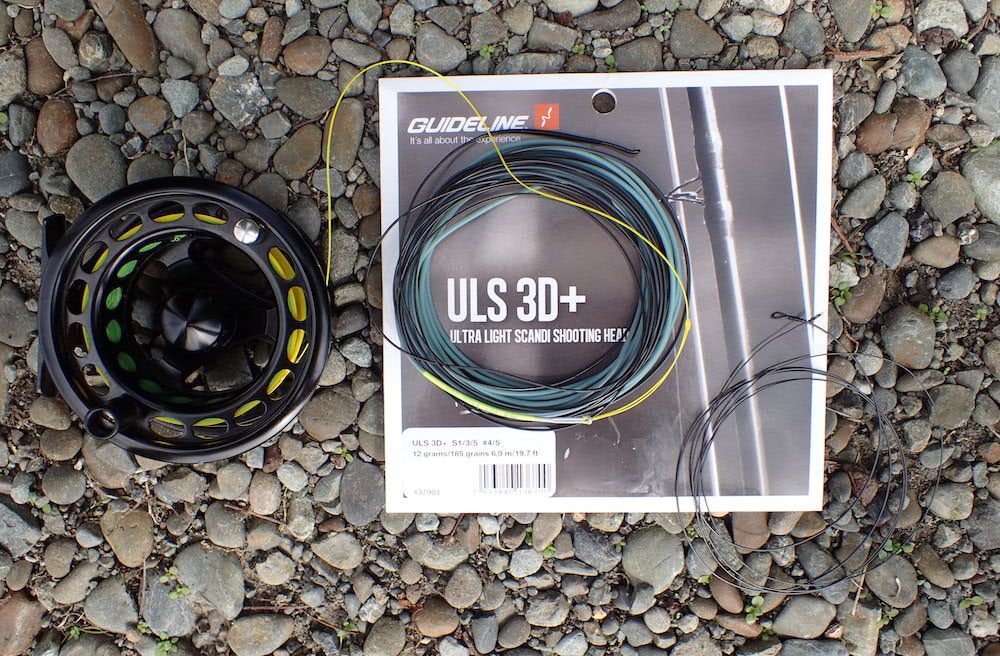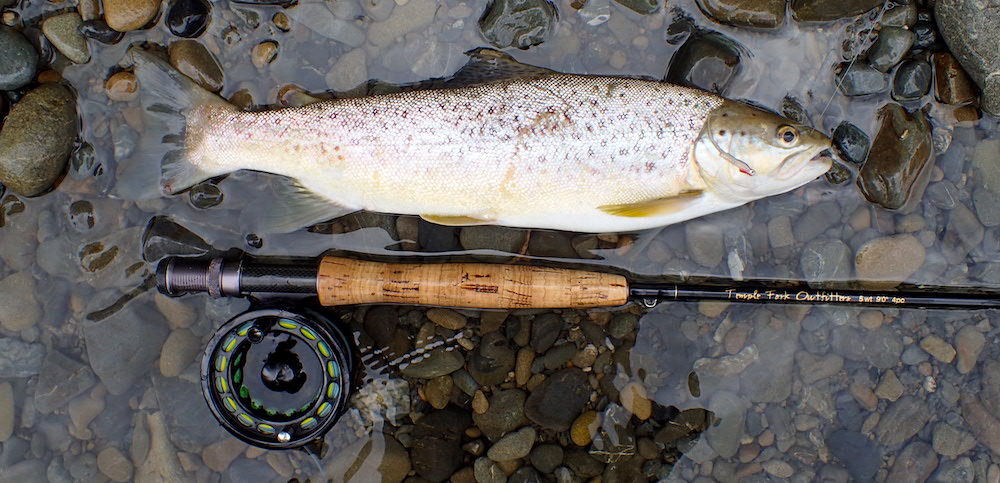My favourite outfits for fishing streamers on small to medium streams were 5 wt single hand rods and 11 ft Scientific Anglers Skagit Lite floating and intermediate heads in 150 and 185 grains.
When SA discontinued their entire range of intermediate Skagit Lite heads in 2021 I began looking for alternatives, and came across the Guideline ULS 3D+ shooting heads. ULS stands for Ultra Light Scandi and the 3D stands for triple density.
The ULS heads are made with a polyurethane coating on a low stretch core and are designed to cast larger streamers on smaller European rivers for sea trout and salmon. They are only 20 ft long, have a 1 foot rear taper, an approximately 5 ft level belly and a 13 ft front taper ending in a fairly thick tip.
ULS heads are available in 185 (4/5), 216 (5/6), 247 (6/7) and 277 (7/8) grains, and in the following densities: float; float/hover/intermediate; hover/int/S3; int/S2/S4; S1/S3/S5; S2/S4/S6 and S3/S5/S7. The S stands for sink rate in inches per second. Head length of the full sinking versions varies from 19.7 to 20.3 ft, depending on grain weight.
Given this length and profile, the sinking versions fall somewhere between 3D Skagit and 3D Scandi and are best described as hybrid heads.
I chose the 185 grain ULS head in S1/S3/S5, instead of a faster sinking option, for the following reasons:
1. I thought this would best emulate the depth achieved with an intermediate Skagit Lite and S6 replacement tip.
2. I use 5wt single hand outfits in summer, when flows are moderate and fish are willing to rise a bit further to hit a streamer.
3. One can always adjust casting angles and apply mends to achieve more depth with a lighter head, but there is not a lot one can do when a head is too heavy and keeps snagging the bottom.
4. I wanted to experiment with adding short S6 tips to the front end, for both casting and depth control, effectively creating a 4D head with a bit more reach.
Casting
The 185 grain ULS S1/S3/S5 head over-head casts exceptionally well, given it’s just under 20 ft long. It was stable in the air and achieved impressive distances.
When it came to Spey casting, the ULS head had considerably less line stick than my 150 grain single hand Skagit set up, even though both head systems have similar length, and I initially had problems blowing anchors with both sustained anchor and touch and go casts.
One solution to the anchor problem with the ULS head was to use a shorter casting stroke and increase line stick by keeping the rod at an angle to the water of less than 90 degrees when making the forward delivery.
In my experience, a better solution to the anchor problem is to add a short sink tip.

Adding Tips
I tried adding the following tips to the ULS S1/S3/S5 head:
1. A 7 ft S6 Sonar Leader
2. Three feet of the level butt section of the S6 Sonar leader
3. Four feet of the tapered front portion of the S6 Sonar leader
4. Two feet of the level butt section of a #5 S6 Replacement tip
5. Four feet of the density compensated tapered front portion of the Replacement Tip
6. Three feet of the density compensated tapered front portion of the Replacement Tip
Adding a tip of appropriate length and weight markedly changed the behaviour of the ULS head for the better. It improved line stick, increased distance and also improved presentation - causing the head to lay out straighter and with less splash. The butt ends of the S6 tips were slightly thinner than the tip of the ULS head, so they essentially extended the taper.
The presentation and distance advantages also applied to overhead casting.
The 3 ft level Sonar Leader butt section, 2 ft level section of the #5 Replacement tip and the 3 ft tip section of the #5 Replacement tip all worked well for larger streamers, i.e. Bead Head Woolly buggers #6, 2.5 inch rabbit tube flies with small tungsten cones, and #2 Clouser Minnows with brass dumb bell eyes. The 2 ft tip had the edge when wading waist deep.
The four foot tip section of the Sonar Leader, with its long fine front taper, was exceptional with unweighted and lightly weighted flies, e.g. bead head woolly buggers up to size 8.
The full 7 ft Sonar leader and the four feet front section of the Replacement Tip were too much for the 185 grain (4/5) head - they were difficult to turn over and they tended to kick to the side.
Compared to Skagit Systems
When it comes to riffles and shallow bouldery runs it’s hard to beat a light floating Skagit head and S3-S7 tip for fishability. The reason being that it’s easy to judge the position of the fly, and depth and speed are easily controlled with appropriate mends and sink tips.
Sinking head systems come into their own in deeper runs and pools, including estuarine channels, and are also better at slicing through wind.
I use my intermediate Skagit heads much more frequently than floating heads when fishing streamers on New Zealand rivers.
The following comparisons with SA intermediate Skagit head systems are all based on the ULS head with short S6 tips attached.
Skagit Lite heads have a belly taper, so when paired with 10 ft tapered Sonar Leaders or Rio Replacement Tips you end up a head system with a delta profile that’s great for Spey casting and produces surprising distance and great presentation - for a Skagit head.
My 150 grain intermediate Skagit Lite head with a 10 ft S6 Sonar Leader (190 grain total weight) has better presentation than the ULS 185 grain S1/S3/S5 head with small streamers, but it does not easily cast further than 60 ft or handle flies heavier than a size 8 bead-head bugger. The 150 grain Skagit system is therefore the better choice for smaller streams, particularly when presentation is important.
Compared to a 180 grain intermediate Skagit Lite with 6 wt S6 Replacement Tip (240 grain total weight) I usually use on medium sized rivers, the ULS head with short tips has much better presentation, and it is also easier to overhead and Scandi cast. I really appreciate the ease with which I can execute a single Spey with the ULS head. Sustained anchor casts were also not a problem.
With a 9 ft T-11 tip I can cast much larger/heavier flies with the 180 grain Skagit head, e.g. lead eyed intruders and large tungsten cones, but generally don’t use flies of that weight on a single hand 5 wt.
Running Lines
Mono running lines work best on the ULS heads, and for the 185 grain heads I would recommend going as thin as possible. Two good options are 30lb OPST Lazar line, which is very thin for its breaking strain, and 25lb Scientific Anglers flat mono.
Making Sink Tips
On the subject of making tips, the most economic approach is to buy a 7 Ft S6 Sonar leader and cut it three foot from the loop on the butt end,to produce two sink tips: a level three foot tip and a four foot finely tapered tip.
To complete the tips, add a 1 ft section of 20 lb Maxima ultra green to the front of the level tip with an Albright knot, and whip finish a loop onto the butt of the tapered tip. Then add 3mm tippet rings to the tips of both tips, using a clinch knot. Use the level tip for heavier flies and the longer tapered tip for lighter ones.
Alternatively, use a damaged #5 S6 Replacement Tip to make your micro tips: 2 ft of level section or 3 ft if including the tapered tip portion.
Which Heads for New Zealand?
Full sinking Guideline ULS heads have become my new favourite head systems for single hand streamer fishing on medium sized New Zealand rivers and estuaries.
These heads can overhead and Spey cast very well, requiring little back casting room, and cast decent sized streamers with great presentation.
Hauling with my left hand increased distance for both over head and Spey casts.
Being as short as they are, ULS 3D+ heads are good for both swinging and stripping streamers, and owing to the small loop on the rear of the head, it’s easy to retrieve the head through the tip eye when required.
When it comes to line weight, I found the 4/5 185 grain ULS 3D+ head and 2-3 ft of S6 sink tip to be a perfect match for a range of 5 wt single hand rods of 9 - 9.5 ft. The sink tips would have added about 20 grains, bringing the total head weight to approximately 205 grains.
A head wallet containing a floating Skagit head and a couple of tips, and ULS heads in S1/S2/S5 and S2/S3/S6, would cover almost every situation encountered when fishing streamers on small to medium rivers, including estuaries. The S3/S5/S7 head would more than likely sink too fast for most situations I would be fishing a 5wt single hand rod.
The cool thing about the ULS sinking heads is the versatility they provide. I can head down to my local estuary first thing in the morning to target sea runs and kahawai with the 185 grain ULS head on my 5 wt rod - it slices through wind and 70 ft casts are easy, even with a #2 Clouser Minnow. Then, when the sun has risen, all I need do is switch spools to put on a regular floating line and I can sight fish my way upstream.
Alternatively, I can fish my way upstream with a floating line and then switch to the shooting head in the afternoon and swing my way back downriver to the car. And if I am on a larger river I can change heads to match the power and depth of the water.
